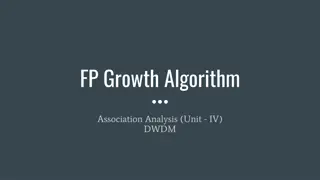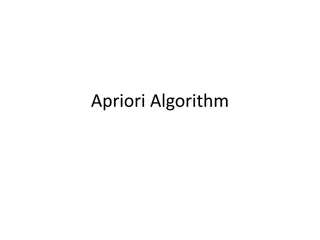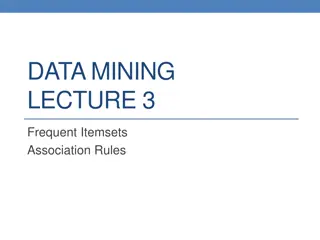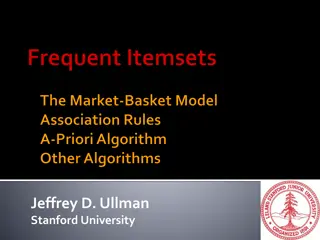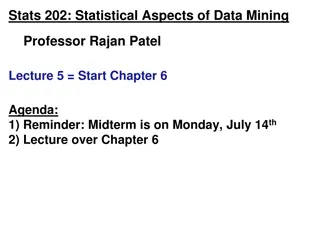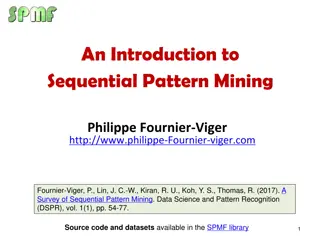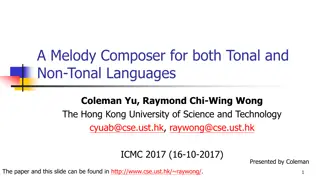Understanding Frequent Patterns and Association Rules in Data Mining
Frequent pattern mining involves identifying patterns that occur frequently in a dataset, such as itemsets and sequential patterns. These patterns play a crucial role in extracting associations, correlations, and insights from data, aiding decision-making processes like market basket analysis. Mining frequent patterns has become a vital aspect of data mining research, facilitating tasks like data classification and clustering.
Download Presentation

Please find below an Image/Link to download the presentation.
The content on the website is provided AS IS for your information and personal use only. It may not be sold, licensed, or shared on other websites without obtaining consent from the author. Download presentation by click this link. If you encounter any issues during the download, it is possible that the publisher has removed the file from their server.
E N D
Presentation Transcript
Mining Frequent Patterns, Associations, and Correlations: Basic Concepts and Methods By Shailaja K.P
Introduction Imagine that you are a sales manager at AllElectronics, and you are talking to a customer who recently bought a PC and a digital camera from the store. What should you recommend to her next? Information about which products are frequently purchased by your customers following their purchases of a PC and a digital camera in sequence would be very helpful in making your recommendation.
Frequent patterns and association rules are the knowledge that you want to mine in such a scenario. Frequent patterns are patterns that appear frequently in a data set. For example, a set of items, such as milk and bread, that appear frequently together in a transaction data set is a frequent itemset. A subsequence, such as buying first a PC, then a digital camera, and then a memory card, if it occurs frequently in a shopping history database, is a (frequent) sequential pattern. A substructure can refer to different structural forms, such as subgraphs, subtrees, or sublattices, which may subsequences. be combined with itemsets or
If a substructure occurs frequently, it is called a (frequent) structured pattern. Finding frequent patterns plays an essential role in mining associations, correlations, and many other interesting relationships among data. Moreover, it helps in data classification, clustering, and other data mining tasks. Thus, frequent pattern mining has become an important data mining task and a focused theme in data mining research.
Basic Concepts Frequent pattern mining searches for recurring relationships in a given data set. Market Basket Analysis: A Motivating Example Frequent itemset mining correlations among items in large transactional or relational data sets. With massive amounts of data continuously being collected and stored, many industries are becoming interested in mining such patterns from their databases. The discovery of interesting correlation relationships among huge amounts of business transaction records can help in many business decision-making processes such as catalog design, cross-marketing, and customer shopping behavior analysis. leads to the discovery of associations and
A typical example of frequent itemset mining is market basket analysis. This process analyzes customer buying habits by finding associations between the different items that customers place in their shopping baskets .
The discovery of these associations can help retailers develop marketing strategies by gaining insight into which items are frequently purchased together by customers. For instance, if customers are buying milk, how likely are they to also buy bread (and what kind of bread) on the same trip to the supermarket? This information can lead to increased sales by helping retailers do selective marketing and plan their shelf space. Let s look at an example of how market basket analysis can be useful.
Example 6.1 Market basket analysis. Suppose, as manager of an AllElectronics branch, you would like to learn more about the buying habits of your customers. Specifically, you wonder, Which groups or sets of items are customers likely to purchase on a given trip to the store? To answer your question, market basket analysis may be performed on the retail data of customer transactions at your store. You can then use the results to plan marketing or advertising strategies, or in the design of a new catalog.
For instance, market basket analysis may help you design different store layouts. In one strategy, items that are frequently purchased together can be placed in proximity to further encourage the combined sale of such items. If customers who purchase computers also tend to buy antivirus software at the same time, then placing the hardware display close to the software display may help increase the sales of both items. In an alternative strategy, placing hardware and software at opposite ends of the store may attract customers who purchase such items to pick up other items along the way. For instance, after deciding on an expensive computer, a customer may observe security systems for sale while heading toward the software display to purchase antivirus software, and may decide to purchase a home security system as well.
Market basket analysis can also help retailers plan which items to put on sale at reduced prices. If customers tend to purchase computers and printers together, then having a sale on printers may encourage the sale of printers as well as computers.
Many Business enterprises accumulate large quantity of data from their day-to- day operations, commonly known as Market-basket transactions. Each row in this table corresponds to a transaction, which contains a unique identifier labelled TID and a set of items bought by a given customer, which is of much interest for learning the purchasing behavior of the customers. TID 1 2 3 4 5 Items {Bread, Milk} {Bread, Diapers, Beer, Eggs} {Milk, Diapers, Beer, Cola} {Bread, Milk, Diapers, Beer} {Bread, Milk, Diapers, Cola}
Market basket data can be represented in a binary format where each row corresponds to a transaction and each column corresponds to an item. An item can be treated as a binary variable whose value is one if the item is present in a transaction and zero otherwise. The Boolean vectors can be analyzed for buying patterns that reflect items that are frequently associated or purchased together. TID 1 2 3 4 Bread 1 1 0 1 Milk 1 0 1 1 Diapers Beer 0 1 1 1 Eggs 0 1 0 0 Cola 0 1 0 0 0 1 1 1
Item set In association analysis, a collection of zero or more items is termed as item set E.g., {Beer, Diapers, Milk} is an example of a 3-itemset The null set is an itemset that does not contain any items Transaction Width Number of items present in a transaction
Association Rule An Association Rule is an implication expression of the form X Y, where X and Y are disjoint itemsets. The strength of an association rule can be measured in terms of its support and confidence. Support Support determines how often a rule is applicable to a given data set. It is the percentage of transactions in D that contain X Y. S(X Y) = (X Y)/ N
Confidence Confidence determines how frequently items in Y appears in transactions that contain X. It is the percentage of transactions containing X that also contain Y. C(X Y) = (X Y)/ (X)
Consider the rule {Milk, Diapers} {Beer} Support count for {Milk, Diapers, Beer} is 2 and total number of transactions is 5, Support = 2/5 = 0.4 (40%) Confidence is obtained by dividing the support count for {Milk, Diapers , Beer} by the support count for {Milk, Diapers} Since there are three transactions that contains milk and diapers, Confidence = 2/ 3= 0.67 (67%)
Given the definitions of transactions T, the goal of association mining is to find all rules having support minsup threshold Confidence minconf threshold In general, association rule mining can be viewed as a two-step process: 1. Frequent Itemset Generation- Find all frequent itemsets, by definition, each of these itemsets will occur at least as frequently as a predetermined minimum support count, minsup threshold. 2. Rule Generation- Generate strong association rules from the frequent itemsets, by definition, these rules must satisfy minimum support and minimum confidence.
Let I = {I1, I2,..., Im} be an itemset. Let D, be a set of database transactions where each transaction T is a nonempty itemset such that T I. Each transaction is associated with an identifier, called a TID. Let A be a set of items. A transaction T is said to contain A if A T. An association rule is an implication of the form A B, where , B , and A B = . The rule A B holds in the transaction set D with support s, where s is the percentage of transactions in D that contain A B (i.e., the union of sets A and B say, or, both A and B). This is taken to be the probability, P(A B). The rule A B has confidence c in the transaction set D, where c is the percentage of transactions in D containing A that also contain B. A I, B I, A
An itemset X is closed in a data set D if there exists no proper super-itemset Y (Y is a proper super-itemset of X if X is a proper sub-itemset of Y, that is, if X Y. In other words, every item of X is contained in Y but there is at least one item of Y that is not in X) such that Y has the same support count as X in D. An itemset X is a closed frequent itemset in set D if X is both closed and frequent in D. An itemset X is a maximal frequent itemset (or max-itemset) in a data set D if X is frequent, and there exists no super-itemset Y such that X Y and Y is frequent in D.
Frequent Itemset Mining Methods Apriori Algorithm: Finding Frequent Itemsets by Confined Candidate Generation Apriori is a important algorithm proposed by R. Agrawal and R. Srikant in 1994 for mining frequent itemsets for Boolean association rule. The name of the algorithm is based on the fact that the algorithm uses prior knowledge of frequent itemset properties. Apriori employs an iterative approach known as a level-wise search, where k-itemsets are used to explore (k + 1)-itemsets. First, the set of frequent 1-itemsets is found by scanning the database to accumulate the count for each item, and collecting those items that satisfy minimum support. The resulting set is denoted by L1. Next, L1is used to find L2, the set of frequent 2-itemsets, which is used to find L3, and so on, until no more frequent k-itemsets can be found. The finding of each Lkrequires one full scan of the database.
Apriori property: All nonempty subsets of a frequent itemset must also be frequent. The Apriori property is based on the following observation. By definition, if an itemset I does not satisfy the minimum support threshold, min sup, then I is not frequent, that is, P(I) < min sup. If an item A is added to the itemset I, then the resulting itemset (i.e., I A) cannot occur more frequently than I. Therefore, I A is not frequent either, that is, P(I A) < min sup. How is the Apriori property used in the algorithm? To understand this, let us look at how Lk 1is used to find Lkfor k 2. A two-step process is followed, consisting of join and prune actions.
1. The join step: To find Lk, a set of candidate k-itemsets is generated by joining Lk 1with itself. This set of candidates is denoted Ck. Let l1and l2be itemsets in Lk 1. The notation li[j] refers to the jth item in li(e.g., l1[k 2] refers to the second to the last item in l1). For efficient implementation, Apriori assumes that items within a transaction or itemset are sorted in lexicographic order. For the (k 1)-itemset, li, this means that the items are sorted such that li[1] < li[2] < < li[k 1]. The join, Lk 1 Lk 1, is performed, where members of Lk 1are joinable if their first (k 2) items are in common.
That is, members l1and l2of Lk1are joined if (l1[1] = l2[1]) (l1[2] = l2[2]) (l1[k 2] = l2[k 2]) (l1[k 1] < l2[k 1]). The condition l1[k 1] < l2[k 1] simply ensures that no duplicates are generated. The resulting itemset formed by joining l1and l2is {l1[1], l1[2],..., l1[k 2], l1[k 1], l2[k 1]}.
2. The prune step: Ckis a superset of Lk, that is, its members may or may not be frequent, but all of the frequent k-itemsets are included in Ck. A database scan to determine the count of each candidate in Ckwould result in the determination of Lk(i.e., all candidates having a count no less than the minimum support count are frequent by definition, and therefore belong to Lk). Ck, however, can be huge, and so this could involve heavy computation. To reduce the size of Ck, the Apriori property is used as follows. Any (k 1)-itemset that is not frequent cannot be a subset of a frequent k- itemset. Hence, if any (k 1)-subset of a candidate k-itemset is not in Lk 1, then the candidate cannot be frequent either and so can be removed from Ck. This subset testing can be done quickly by maintaining a hash tree of all frequent itemsets.
Apriori Example . Lets look at a concrete example, based on the AllElectronics transaction database, D, of table below There are nine transactions in this database, that is, |D| = 9.
We use Figure below to illustrate the Apriori algorithm for finding frequent itemsets in D.
1. In the first iteration of the algorithm, each item is a member of the set of candidate 1-itemsets, C1. The algorithm simply scans all of the transactions to count the number of occurrences of each item. 2. Suppose that the minimum support count required is 2, that is, min sup = 2. (Here, we are referring to absolute support because we are using a support count. The corresponding relative support is 2/9 = 22%.) The set of frequent 1- itemsets, L1, can then be determined. It consists of the candidate 1-itemsets satisfying minimum support. In our example, all of the candidates in C1satisfy minimum support. 3. To discover the set of frequent 2-itemsets, L2, the algorithm uses the join L1 L1to generate a candidate set of 2-itemsets, C2. C2consists of 2- itemsets. Note that no candidates are removed from C2during the prune step because each subset of the candidates is also frequent. 4. Next, the transactions in D are scanned and the support count of each candidate itemset in C2is accumulated, as shown in the middle table of the second row in Figure.
5. The set of frequent 2-itemsets, L2, is then determined, consisting of those candidate 2-itemsets in C2having minimum support. 6. The generation of the set of the candidate 3-itemsets, C3, is detailed below.
From the join step, we first get C3= L2 L2= {{I1, I2, I3}, {I1, I2, I5}, {I1, I3, I5}, {I2, I3, I4}, {I2, I3, I5}, {I2, I4, I5}}. Based on the Apriori property that all subsets of a frequent itemset must also be frequent, we can determine that the four latter candidates cannot possibly be frequent. We therefore remove them from C3, thereby saving the effort of unnecessarily obtaining their counts during the subsequent scan of D to determine L3. Note that when given a candidate k- itemset, we only need to check if its (k 1)-subsets are frequent since the Apriori algorithm uses a level-wise search strategy. The resulting pruned version of C3is shown in the first table of the bottom row of Figure, 7. The transactions in D are scanned to determine L3, consisting of those candidate 3-itemsets in C3having minimum support. 8. The algorithm uses L3 L3 to generate a candidate set of 4-itemsets, C4. Although the join results in {{I1, I2, I3, I5}}, itemset {I1, I2, I3, I5} is pruned because its subset {I2, I3, I5} is not frequent. Thus, C4= , and the algorithm terminates, having found all of the frequent itemsets.
Figure below shows pseudocode for the Apriori algorithm and its related procedures.
Step 1 of Apriori finds the frequent 1-itemsets, L1. In steps 2 through 10, Lk 1is used to generate candidates Ckto find Lkfor k 2. The apriori gen procedure generates the candidates and then uses the Apriori property to eliminate those having a subset that is not frequent (step 3). Once all of the candidates have been generated, the database is scanned (step 4). For each transaction, a subset function is used to find all subsets of the transaction that are candidates (step 5), and the count for each of these candidates is accumulated (steps 6 and 7). Finally, all the candidates satisfying the minimum support (step 9) form the set of frequent itemsets, L (step 11).
A procedure can then be called to generate association rules from the frequent itemsets. The apriori gen procedure performs two kinds of actions, namely, join and prune. In the join component, Lk 1is joined with Lk 1to generate potential candidates (steps 1 4). The prune component (steps 5 7) employs the Apriori property to remove candidates that have a subset that is not frequent. The test for infrequent subsets is shown in procedure has infrequent subset.
Example- TID 1 2 3 4 5 Items Bread, Milk Bread, Diaper, Beer, Eggs Milk, Diaper, Beer, Coke Bread, Milk, Diaper, Beer Bread, Milk, Diaper, Coke Assume the support threshold to be 60%, which is equivalent to a minimum support count equal to 3 Initially, every item is considered as a candidate 1-itemset
Items (1-itemsets) Item Bread Coke Milk Beer Diaper Eggs Count 4 2 4 3 4 1 Pairs (2-itemsets) Itemset {Bread,Milk} {Bread,Beer} {Bread,Diaper} {Milk,Beer} {Milk,Diaper} {Beer,Diaper} Count 3 2 3 2 3 3 (No need to generate candidates involving Coke or Eggs) Minimum Support = 3 Triplets (3-itemsets) Itemset {Bread,Milk,Diaper} Count 3
After counting their supports, the candidate itemsets {Cola} and {Eggs} are discarded because they appear in fewer than three transactions In the next iteration, candidate 2-itemsets are generated using only the frequent 1-itemsets because the Apriori principle ensures that all supersets of the infrequent 1-itemsets must be infrequent Because there are only four frequent 1-itemsets, the number of candidate 2- itemsets generated by the algorithm is (42 ) = 6 Two of these six candidates {Beer, Bread} and {Beer, Milk} are subsequently found to be infrequent after computing their support values The remaining four candidates are frequent, and thus will be used to generate candidate 3-itemsets With the Apriori principle, we need only to keep candidate 3-itemsets whose subsets are frequent The only candidate that has this property is {Bread, Diapers, Milk}
The effectiveness of Apriori pruning strategy can be shown by counting the number of candidate itemsets generated With Apriori principle, the number of candidate itemset generated is computed as (61) + (42) + 1 = 6 + 6 + 1 = 13 candidates
Generating Association Rules from Frequent Itemsets Once the frequent itemsets from transactions in a database D have been found, it is straightforward to generate strong association rules from them (where strong association rules satisfy both minimum support and minimum confidence). This can be done using Eq. for confidence The conditional probability is expressed in terms of itemset support count, where support count(A B) is the number of transactions containing the itemsets A B, and support count(A) is the number of transactions containing the itemset A.
Based on this equation, association rules can be generated as follows: Because the rules are generated from frequent itemsets, each one automatically satisfies the minimum support. Frequent itemsets can be stored ahead of time in hash tables along with their counts so that they can be accessed quickly.
Example -Generating association rules. Let s try an example based on the transactional data for AllElectronics shown before in Table 6.1. The data contain frequent itemset X = {I1, I2, I5}. What are the association rules that can be generated from X? The nonempty subsets of X are {I1, I2}, {I1, I5}, {I2, I5}, {I1}, {I2}, and {I5}. The resulting association rules are as shown below, each listed with its confidence: If the minimum confidence threshold is, say, 70%, then only the second, third, and last rules are output, because these are the only ones generated that are strong.
Improving the Efficiency of Apriori How can we further improve the efficiency of Apriori-based mining? Many variations of the Apriori algorithm have been proposed that focus on improving the efficiency of the original algorithm. Several of these variations are summarized as follows:
Hash-based technique (hashing itemsets into corresponding buckets): A hash-based technique can be used to reduce the size of the candidate k- itemsets, Ck , for k > 1. Hash table is used as data structure. First iteration is required to count the support of each element. From second iteration, efforts are made to enhance execution of Apriori by utilizing hash table concept Hash table minimizes the number of item set generated in second iteration. In second iteration, i.e. 2-item set generation, for every combination of two items, we map them to diverse bucket of hash table structure and increment the bucket count. If count of bucket is less than min.sup_count, we remove them from candidate sets.
A 2-itemset with a corresponding bucket count in the hash table that is below the support threshold cannot be frequent and thus should be removed from the candidate set. Such a hash-based technique may substantially reduce the number of candidate k-itemsets examined (especially when k = 2).
Partitioning (partitioning the data to find candidate itemsets): A partitioning technique can be used that requires just two database scans to mine the frequent itemsets (Figure below).
It consists of two phases. In phase I, the algorithm divides the transactions of D into n non-overlapping partitions. If the minimum relative support threshold for transactions in D is min sup, then the minimum support count for a partition is min sup the number of transactions in that partition. Example- consider the transactions in the Boolean form. I1 1 0 0 0 0 0 I2 0 1 0 1 0 1 I3 0 0 0 1 0 1 I4 0 1 1 0 0 1 I5 1 0 1 0 1 0 T1 T2 T3 T4 T5 T6
Database is divided into three partitions.,each having two transactions with a support of 20% the support count is 1 for local i.e 20% of 2 transactions is 1. The support count is 3 for global ie. 20% of 6 is 2.
For each partition, all the local frequent itemsets (i.e., the itemsets frequent within the partition) are found. A local frequent itemset may or may not be frequent with respect to the entire database, D. However, any itemset that is potentially frequent with respect to D must occur as a frequent itemset in at least one of the partitions. Therefore, all local frequent itemsets are candidate itemsets with respect to D. The collection of frequent itemsets from all partitions forms the global candidate itemsets with respect to D. In phase II, a second scan of D is conducted in which the actual support of each candidate is assessed to determine the global frequent itemsets. Partition size and the number of partitions are set so that each partition can fit into main memory and therefore be read only once in each phase.
A Pattern-Growth Approach for Mining Frequent Itemsets In many cases the Apriori candidate generate-and-test method significantly reduces the size of candidate sets, leading to good performance gain. However, it can suffer from two nontrivial costs: It may still need to generate a huge number of candidate sets. For example, if there are 104 frequent 1-itemsets, the Apriori algorithm will need to generate more than 107 candidate 2-itemsets. It may need to repeatedly scan the whole database and check a large set of candidates by pattern matching. It is costly to go over each transaction in the database to determine the support of the candidate itemsets.
Can we design a method that mines the complete set of frequent itemsets without such a costly candidate generation process? An interesting method in this attempt is called frequent pattern growth, or simply FP-growth, which adopts a divide-and-conquer strategy as follows. First, it compresses the database representing frequent items into a frequent pattern tree, or FP-tree, which retains the itemset association information. It then divides the compressed database into a set of conditional databases, each associated with one frequent item or patternfragment, and mines each database separately. For each patternfragment, only its associated data sets need to be examined. Therefore, this approach may substantially reduce the size of the data sets to be searched, along with the growth of patterns being examined.
Example -FP-growth (finding frequent itemsets without candidate generation). We reexamine the mining of transaction database, D, of Table below using the frequent pattern growth approach. The first scan of the database is the same as Apriori, which derives the set of frequent items (1-itemsets) and their support counts (frequencies). Let the minimum support count be 2. The set of frequent items is sorted in the order of descending support count. This resulting set or list is denoted by L. Thus, we have L = {{I2: 7}, {I1: 6}, {I3: 6}, {I4: 2}, {I5: 2}}.





